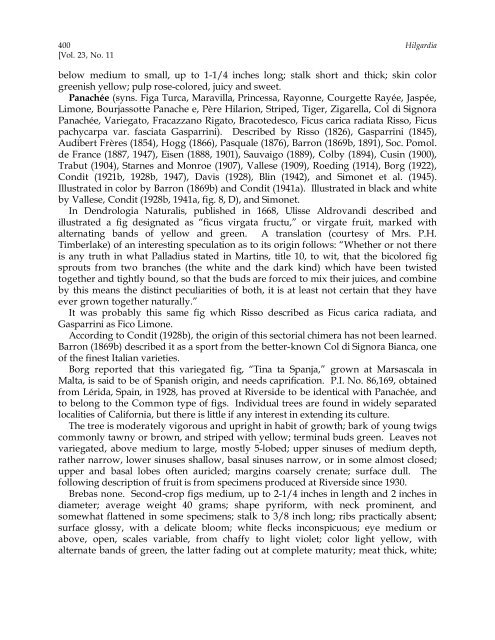Fig Varieties: A Monograph - uri=ucce.ucdavis
Fig Varieties: A Monograph - uri=ucce.ucdavis
Fig Varieties: A Monograph - uri=ucce.ucdavis
You also want an ePaper? Increase the reach of your titles
YUMPU automatically turns print PDFs into web optimized ePapers that Google loves.
400 Hilgardia<br />
[Vol. 23, No. 11<br />
below medium to small, up to 1-1/4 inches long; stalk short and thick; skin color<br />
greenish yellow; pulp rose-colored, juicy and sweet.<br />
Panachée (syns. <strong>Fig</strong>a Turca, Maravilla, Princessa, Rayonne, Courgette Rayée, Jaspée,<br />
Limone, Bourjassotte Panache e, Père Hilarion, Striped, Tiger, Zigarella, Col di Signora<br />
Panachée, Variegato, Fracazzano Rigato, Bracotedesco, Ficus carica radiata Risso, Ficus<br />
pachycarpa var. fasciata Gasparrini). Described by Risso (1826), Gasparrini (1845),<br />
Audibert Frères (1854), Hogg (1866), Pasquale (1876), Barron (1869b, 1891), Soc. Pomol.<br />
de France (1887, 1947), Eisen (1888, 1901), Sauvaigo (1889), Colby (1894), Cusin (1900),<br />
Trabut (1904), Starnes and Monroe (1907), Vallese (1909), Roeding (1914), Borg (1922),<br />
Condit (1921b, 1928b, 1947), Davis (1928), Blin (1942), and Simonet et al. (1945).<br />
Illustrated in color by Barron (1869b) and Condit (1941a). Illustrated in black and white<br />
by Vallese, Condit (1928b, 1941a, fig. 8, D), and Simonet.<br />
In Dendrologia Naturalis, published in 1668, Ulisse Aldrovandi described and<br />
illustrated a fig designated as “ficus virgata fructu,” or virgate fruit, marked with<br />
alternating bands of yellow and green. A translation (courtesy of Mrs. P.H.<br />
Timberlake) of an interesting speculation as to its origin follows: “Whether or not there<br />
is any truth in what Palladius stated in Martins, title 10, to wit, that the bicolored fig<br />
sprouts from two branches (the white and the dark kind) which have been twisted<br />
together and tightly bound, so that the buds are forced to mix their juices, and combine<br />
by this means the distinct peculiarities of both, it is at least not certain that they have<br />
ever grown together naturally.”<br />
It was probably this same fig which Risso described as Ficus carica radiata, and<br />
Gasparrini as Fico Limone.<br />
According to Condit (1928b), the origin of this sectorial chimera has not been learned.<br />
Barron (1869b) described it as a sport from the better-known Col di Signora Bianca, one<br />
of the finest Italian varieties.<br />
Borg reported that this variegated fig, “Tina ta Spanja,” grown at Marsascala in<br />
Malta, is said to be of Spanish origin, and needs caprification. P.I. No. 86,169, obtained<br />
from Lérida, Spain, in 1928, has proved at Riverside to be identical with Panachée, and<br />
to belong to the Common type of figs. Individual trees are found in widely separated<br />
localities of California, but there is little if any interest in extending its culture.<br />
The tree is moderately vigorous and upright in habit of growth; bark of young twigs<br />
commonly tawny or brown, and striped with yellow; terminal buds green. Leaves not<br />
variegated, above medium to large, mostly 5-lobed; upper sinuses of medium depth,<br />
rather narrow, lower sinuses shallow, basal sinuses narrow, or in some almost closed;<br />
upper and basal lobes often auricled; margins coarsely crenate; surface dull. The<br />
following description of fruit is from specimens produced at Riverside since 1930.<br />
Brebas none. Second-crop figs medium, up to 2-1/4 inches in length and 2 inches in<br />
diameter; average weight 40 grams; shape pyriform, with neck prominent, and<br />
somewhat flattened in some specimens; stalk to 3/8 inch long; ribs practically absent;<br />
surface glossy, with a delicate bloom; white flecks inconspicuous; eye medium or<br />
above, open, scales variable, from chaffy to light violet; color light yellow, with<br />
alternate bands of green, the latter fading out at complete maturity; meat thick, white;
















![Fig Trees in North Carolina [Archive] - IDigMyGarden ... - Figs 4 Fun](https://img.yumpu.com/26905320/1/190x245/fig-trees-in-north-carolina-archive-idigmygarden-figs-4-fun.jpg?quality=85)